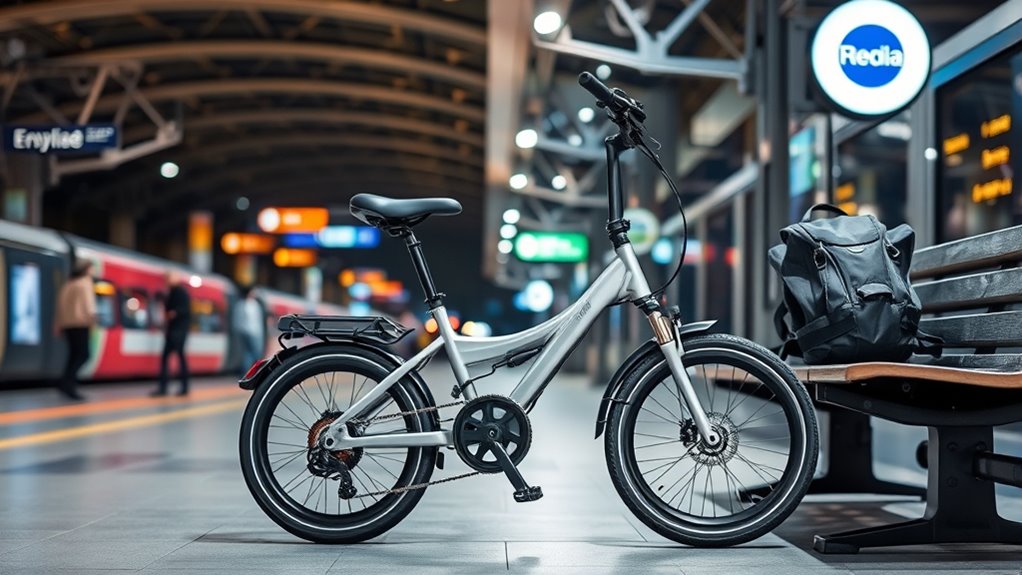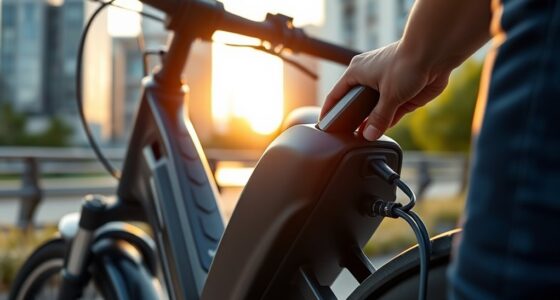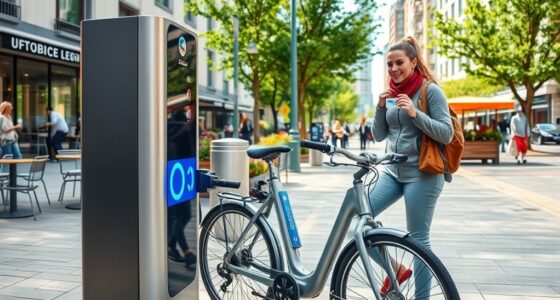To travel with your e-bike on public transport, first check the transit provider’s policies on bike size, folding, and accessories. Fully charge your battery, secure removable parts, and pack accessories separately. Use a bike cover or bag, and lock the bike to prevent theft. Be aware of space limits, fare requirements, and designated areas. Following these guidelines helps guarantee a smooth, compliant journey, and if you continue exploring, you’ll discover more essential tips for a hassle-free trip.
Key Takeaways
- Check transit provider policies on e-bike size, folding requirements, and accessories before travel.
- Fully charge your e-bike battery and remove loose accessories to ensure safety and compliance.
- Disassemble or fold parts like pedals and handlebars to fit your e-bike in designated transit spaces.
- Secure your e-bike with straps or locks and use covers to prevent damage during transit.
- Arrive early, follow rules for bike placement, and ensure proper ticketing or fare payment if required.
Understanding Public Transport Policies for E‑Bikes
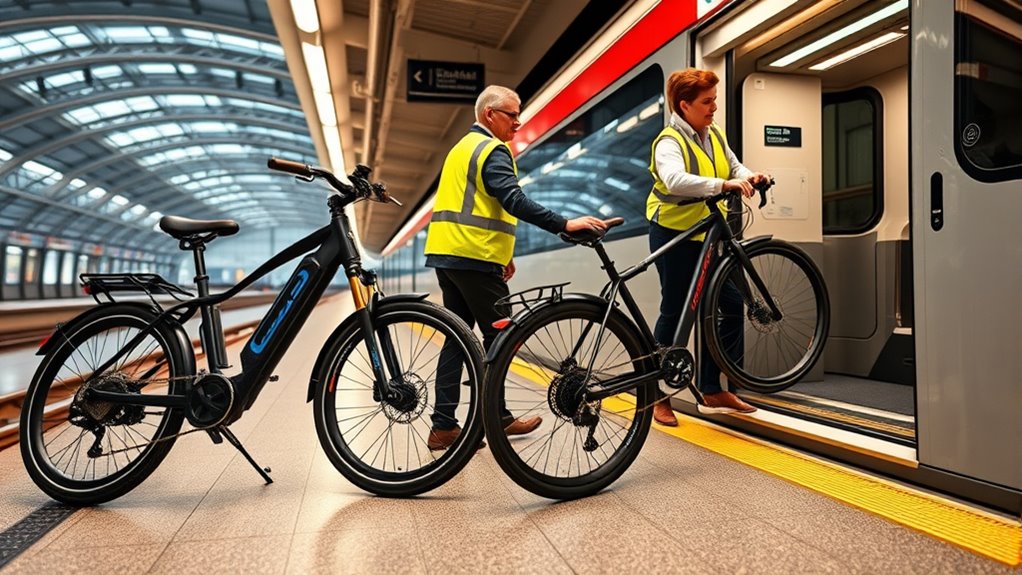
To successfully travel with an e-bike on public transport, you need to understand the policies of each transit provider. Many transit systems have specific rules about bringing e-bikes onboard, often restricting size or requiring bikes to be folded. Check if bike accessories like racks or panniers are allowed, as some services limit additional gear. Making sure your e-bike is well-maintained is essential; a smoothly functioning e‑bike reduces issues during boarding. Some transit agencies may require you to carry your e-bike in a bag or case, especially if it’s not foldable. Always review the rules beforehand to avoid surprises and comply. Being aware of forsale 100 guidelines can help you plan better, keeps your e‑bike safe, and makes your journey smoother.
Preparing Your E‑Bike Before Travel
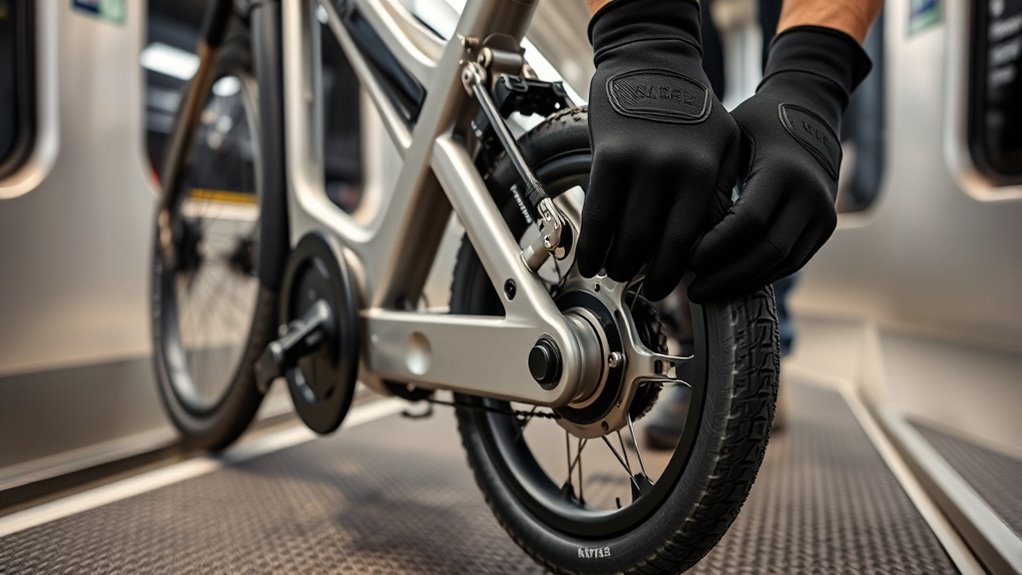
Before you travel, make sure to check public transport regulations regarding e-bikes to avoid surprises. Fully charge your battery so you’re ready for your ride without interruptions. Finally, secure your e-bike properly to prevent damage or theft during transit. Additionally, familiarize yourself with portability features, which can make handling your e-bike more convenient during your journey.
Check Transport Regulations
Checking transport regulations is crucial to guarantee your e-bike complies with the rules of the carrier you’ll use. Different providers have specific restrictions, so it’s important to research beforehand. Ensure your bike accessories, like lights and reflectors, meet safety standards. Confirm if there are size or weight limits for e-bikes, and whether you need to disassemble parts such as pedals or handlebars. Also, review policies on e bike maintenance, like whether you need to disconnect the battery or remove certain components. Being informed helps you avoid surprises at the station or onboard. When in doubt, contact customer service for clarification. Proper preparation ensures a smooth journey and respects the rules of public transport, making your travel experience hassle-free. Additionally, understanding Mazda Tuning concepts can inspire modifications that enhance your vehicle’s performance and comfort during transit.
Fully Charge the Battery
Ensuring your e-bike’s battery is fully charged before your trip prevents unexpected stops and delays. Proper battery maintenance means starting with a full charge, so you can explore without worry. Before departure, locate nearby charging stations or ensure your battery is topped off at home. A well-charged battery boosts confidence, reduces stress, and keeps your journey smooth. Remember, leaving your battery partially drained can compromise its lifespan over time. Regularly maintaining your battery guarantees reliable performance during travel. Being aware of battery longevity can help you plan better and avoid inconvenient situations during your trips. Here’s a reminder of how it feels when everything aligns:
| Fully Charged | No Worries | Smooth Ride |
|---|---|---|
| Confidence | Freedom | Adventure |
| Reliability | Peace of Mind | Excitement |
| Preparedness | Joy | Exploration |
Secure the E-Bike
To keep your e-bike secure during travel, you need to take proactive steps to prevent theft or damage. Start by removing any valuable bike accessories, such as lights or GPS devices, to reduce temptation. Ensure your e-bike is properly maintained—check tire pressure, brakes, and the battery lock to avoid issues en route. Use a sturdy lock to secure the frame and wheels to an immovable object, and consider locking the saddle or removing it if possible. Additionally, cover your e-bike with a protective cover to deter theft and protect it from weather. Regular e bike maintenance also helps keep your bike in excellent condition, minimizing risks during transit. These measures ensure your e-bike stays safe and ready for your next ride.
Packing and Securing Your E‑Bike for Transit

Before you load your e-bike onto public transportation, it’s essential to properly pack and secure it to prevent damage and guarantee safety. Start by removing any loose bike accessories, like lights or water bottles, and pack them separately. Use appropriate cycling apparel, such as padded gloves or a helmet, to protect yourself during handling. Fold or remove detachable parts, like pedals or handlebars, to minimize space and reduce risk of breakage. Secure the bike with straps or bungee cords to prevent movement during transit. Consider using a sturdy bike bag or a protective cover to shield your e-bike from scratches and dirt. Taking these steps ensures your e-bike stays safe and intact, making your journey smooth and worry-free.
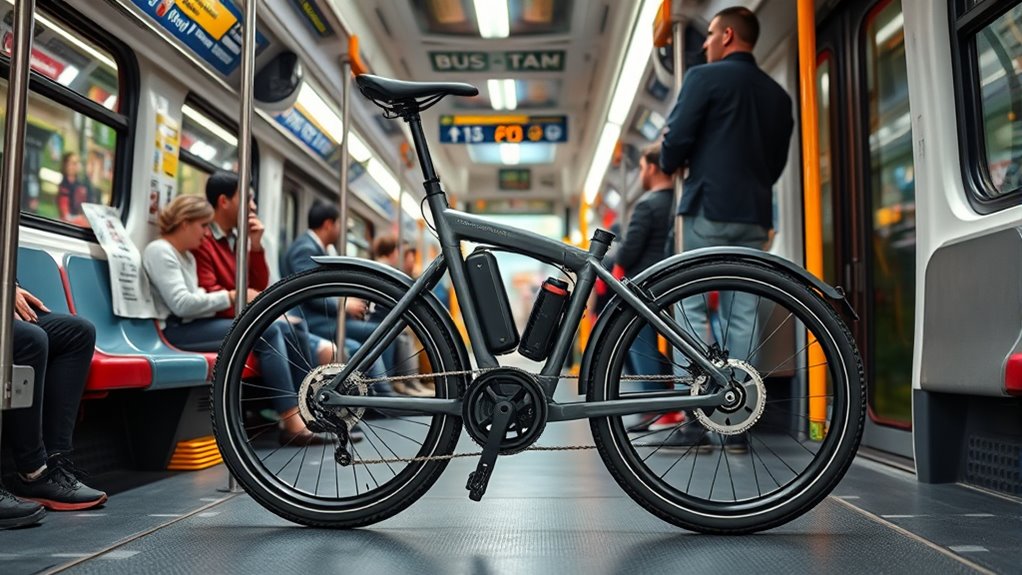
When taking your e-bike on buses or trams, you need to check size restrictions to make certain it fits comfortably. You’ll also want to understand the boarding procedures and whether you need to pay extra fares. Knowing these rules helps you travel smoothly without surprises or delays. Additionally, familiarizing yourself with public transport policies on storage options can make your journey more convenient.
Bus/Tram Size Restrictions
Ever wonder how size restrictions impact your ability to bring an e-bike on buses and trams? Many transit systems have specific dimensions for bikes, often limiting size to ensure passenger comfort. If your e-bike exceeds these limits, you might need to think about alternative options or disassemble parts for easier transport. To streamline your journey, keep these tips in mind:
- Check the maximum length, width, and height allowed for bikes
- Remove or fold bike accessories that increase size
- Maintain your e-bike regularly to prevent unexpected issues during transit
- Consider disassembling your bike for easier storage
- Recognize that angel number meanings can sometimes signal ideal times to embark on new travel routines or make adjustments to your transportation plans.
Being aware of these restrictions helps prevent last-minute surprises. Proper e bike maintenance ensures your bike stays within size limits, and understanding these rules simplifies your travel experience.
Boarding Procedures for Bikes
Knowing the size restrictions is just the starting point; successfully boarding your e-bike requires understanding the specific procedures each bus or tram system has in place. Before boarding, ensure your e-bike is well-maintained, with proper bike maintenance, so it’s easy to handle. Some systems require you to fold your e bike accessories or secure loose parts to prevent damage during transit. You might need to use designated bike areas or special racks; check if your system has clear instructions for loading your e-bike safely. Always wait for the driver’s signal or permission before attempting to board with your bike. Being familiar with these procedures minimizes delays and guarantees your e-bike is transported securely, respecting the rules of the transit system. Additionally, understanding the self-watering plant pots can help you manage your plants effectively during travel or extended absences.
Payment and Fare Policies
Are you aware of how different transit systems handle fares for transporting your e-bike? Many require specific fare policies, such as paying an additional fee or obtaining a special ticket. Be sure to check if your system offers fare discounts for bike passengers, which can save you money. When boarding, make certain you validate your ticket correctly to avoid fines. Some systems may allow free or discounted bike transport during off-peak hours. Others require you to purchase a separate bike ticket. Remember:
- Verify if fare discounts apply for bike travelers
- Follow ticket validation procedures carefully
- Check if extra fees are required
- Confirm bike-specific rules before boarding
Understanding these policies helps you navigate bus and tram rules smoothly, ensuring a hassle-free journey with your e-bike. Additionally, reviewing bike-specific rules can prevent potential issues and make your travel experience more seamless.
Traveling With E‑Bikes on Trains and Subways

Traveling with an e-bike on trains and subways can be convenient, but it requires some planning to comply with transit policies. Before you travel, check the specific rules about bike storage, as many transit systems allow folding e-bikes during off-peak hours or in designated areas. Keeping your bike well-maintained ensures smooth boarding and disembarking. E-bikes promote eco-friendly travel, so choosing public transport helps reduce your carbon footprint. Be mindful of space limitations and always follow posted guidelines. Additionally, understanding popular delivery options can help you plan for meals if you’re on the go. To simplify your journey, use the table below to understand common policies across transit systems:
| Transit System | E-bike Policy |
|---|---|
| Metro A | Folding bikes only, off-peak hours |
| Subway B | Full-sized bikes allowed, designated areas |
| Train C | No bikes during rush hours |
| Light Rail D | Bikes permitted with ticket purchase |
| Bus E | Folded bikes in designated racks |
Tips for Smooth Boarding and Disembarking
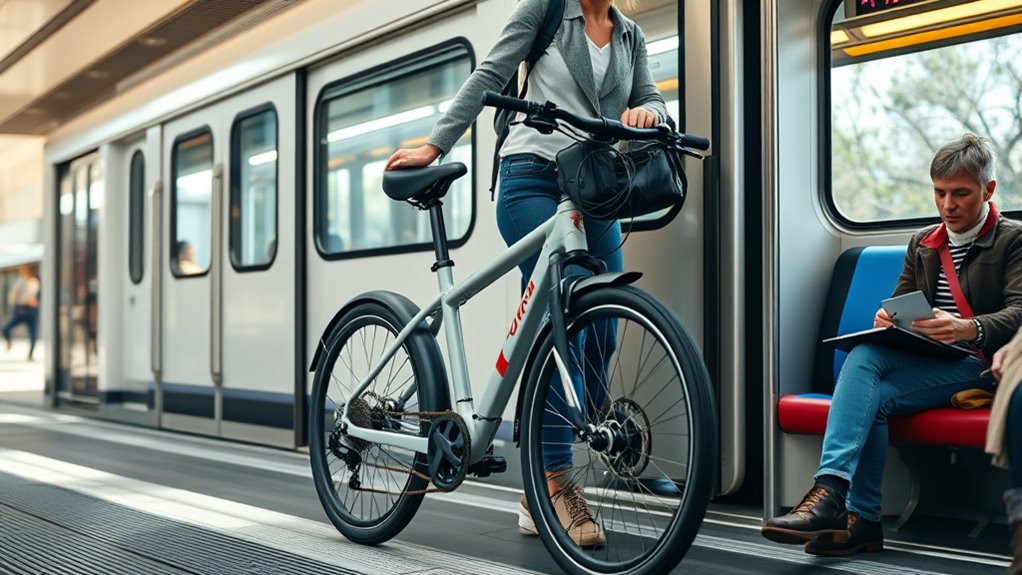
To guarantee a smooth boarding and disembarking process with your e-bike, plan ahead by arriving early and positioning yourself near designated entry points. This gives you ample time to handle your bike accessories and prepare for movement. Before boarding, ensure your e-bike is well-maintained to prevent issues that could slow you down. When boarding, communicate clearly with staff and fellow passengers to avoid congestion. Use these tips for ease:
- Remove or secure any loose bike accessories to prevent delays.
- Fold or detach removable parts to fit more comfortably.
- Keep your e-bike’s battery charged to avoid technical hiccups.
- Know your vehicle’s specific procedures for handling e-bikes during boarding and disembarking.
- Additionally, understanding paint preparation and equipment maintenance can help ensure your e-bike remains in optimal condition for travel.
Ensuring Safety and Compliance During Your Journey
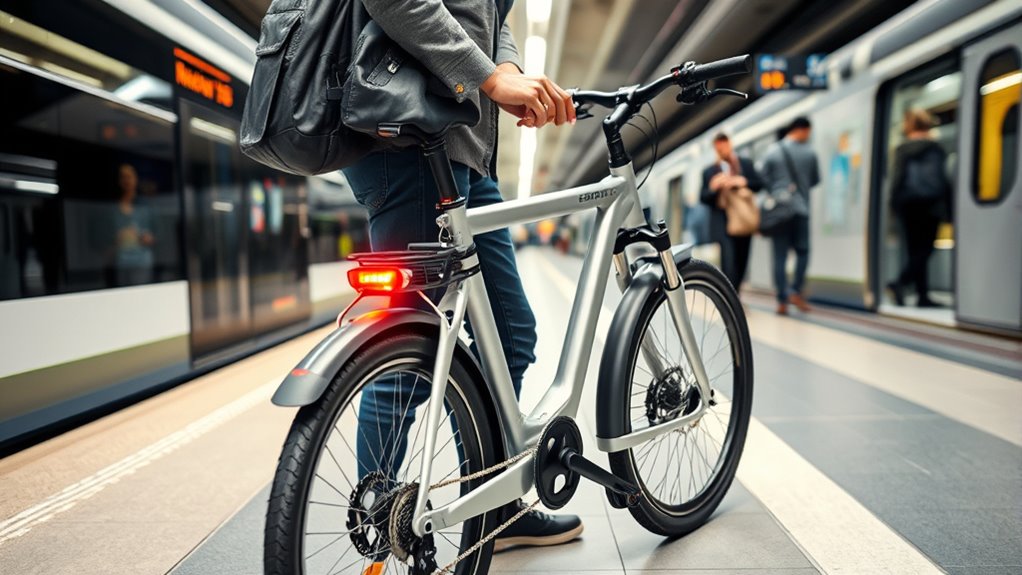
Ensuring safety and compliance during your journey requires you to stay alert and follow established rules. Before traveling, check your bike maintenance to guarantee your e‑bike is in good condition, especially brakes and tires. Using the right e bike accessories, like reflective gear or lights, enhances visibility and safety. Always secure your bike properly, following the transport provider’s guidelines to prevent accidents or damage. Keep your e‑bike on designated areas and avoid blocking aisles. Stay aware of local regulations regarding e‑bike use and transport rules. Additionally, understanding the sound vibrations involved in sound therapy can help you appreciate the importance of maintaining proper equipment and safety standards. By maintaining your bike and using the proper accessories, you reduce risks and ensure a smooth, compliant journey. Being proactive about safety not only protects you but also helps others enjoy a safe and pleasant travel experience.
Frequently Asked Questions
Can I Travel With an E-Bike on All Types of Public Transport?
You might wonder if you can take your e-bike on all public transport. While many options like trains, buses, and trams allow e-bikes, rules vary. Always check bike safety and battery regulations beforehand, since some transport systems restrict battery types or size. Ensuring your e-bike is properly folded or stored can help. Confirm specific policies to avoid surprises, and be considerate of other passengers when traveling with your e-bike.
Are There Size or Weight Restrictions for E-Bikes on Public Transit?
When it comes to size and weight restrictions for your e-bike on public transit, you need to take into account battery regulations and folding bike considerations. Many transit systems limit bikes to a certain size or weight, especially for non-folding models. Folding bikes often face fewer restrictions because they’re more compact. Always check specific transit rules beforehand, ensuring your e-bike fits within the allowed limits for safe, hassle-free travel.
Do I Need Special Permits to Carry an E-Bike?
You usually don’t need special permits to carry an e-bike, but it’s wise to check local rules first. Be aware of battery regulations, as some transit systems restrict lithium-ion batteries due to safety concerns. Also, review insurance requirements, since some carriers may require you to have coverage for your e-bike during transit. Always verify with your transit provider to avoid surprises and make certain a smooth trip.
How Do I Handle E-Bikes During Peak Travel Hours?
Imagine you’re commuting during rush hour with your e-bike. To handle peak travel hours, you should plan for proper storage solutions that keep your bike secure and manageable. Always follow battery regulations to prevent hazards, like avoiding charging or storing your e-bike in crowded areas. Consider foldable models for easy storage, and arrive early to secure space. Stay aware of transit policies, and your ride will be smooth even during busy times.
What Are the Costs Associated With Transporting an E-Bike?
When considering transporting your e-bike, you’ll want to look at the cost comparison for different options, such as train, bus, or specialized bike carriers. These costs vary depending on distance and provider policies. Don’t forget insurance considerations—some transit services may require additional coverage or fees for high-value bikes. Planning ahead helps you avoid surprises, ensuring your e-bike travels safely without breaking the bank.
Conclusion
Traveling with your e-bike can be seamless if you understand the rules and prepare properly. Sometimes, it’s the little details—like securing your bike or knowing transit policies—that make all the difference. Just like a chance encounter can change your day, proper planning transforms your journey into a smooth adventure. Embrace the process, and you’ll find that combining transit and e-biking opens up new horizons you never expected. Safe travels!
